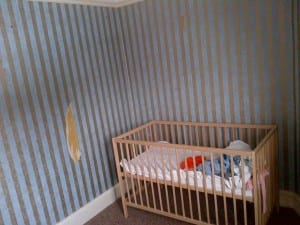For our final piece the CCTV group decided to create a piece of installation art using the fascinating piece of equipment at our disposal. Marita Sturken states that “An installation both defines and contains space, situating, if not controlling the viewer within it.” (( Erika Suderburg (2000) Space, Site, Intervention: situating installation art. Minneapolis: University of Minnesota Press. P. 287 )) The idea for our piece was that while in the CCTV room the audience would be able to experience every other room in the house, placing them in a position where they could understand the format and use of the space in a way that they had not experienced it in the rest of the performance. Seeing as all of the rooms were occupied during the performance we decided to see what it would be like for the rooms to be captured with very few signs of life, and once we realised the potential that this emptiness created we decided to stick with it.
Full screen night filming by Lizzy Hayes, Lauren Hughes, Faye Mcdool
Seeing the rooms from a different perspective reminded me of Bollnows Human Spaces (2011) and how different each of our safe house rooms were from the definitions and purposes he proposed. Bollnow states that the furnishings and furniture play a part in the aura of a room and that “bare, empty rooms have a chilling effect” ((Bollnow, O.F (2011) “Human Space” London: Hyphen Press, p. 144)) and that “disorder and neglect have a quieting effect” ((Bollnow, O.F (2011) “Human Space” London: Hyphen Press, p. 144)) and due to the empty and neglected state the house was in it was easy to agree with him.
The emptiness and neglected state of the house became emphasised in the dark state that we filmed in.
Image by Jozey Wade 2013
The cot room (above) had a chilling, spooky quality to it that does not represent home, even in the day light. As many of the ‘residents’ have mentioned, we doubt that the room would feel that bad if it wasn’t for the presence of the cot itself. But I think it was key for us to remember when filming was that the room was made to feel so unsettling on purpose. The true nurturing purpose of a child’s nursery is lost in a sort of dark translation in the house due its requirements for training and we were able to use that to our advantage when filming, making the images we captured as uncomfortable as the actor being filmed felt.
Installation piece- Cot Room By Lizzy Hayes, Lauren Hughs, Faye Mcdool
Other spaces that in the day time might not be pleasant, but had never been scary, transformed beyond what I imagined they would. The kitchen became colder and harsher and the introduction of a spot light to the living room gave the opposite effect to the warmth that we expected.
Instead of just filming the bare rooms we had one of us walk through or occupy the space in a minimalistic manner. Bollnow suggested that “the dwelling becomes an impression of the individual who dwells in it” ((Bollnow, O.F (2011) “Human Space” London: Hyphen Press, p. 145)) and I think that in capturing snippets of life in each room we were in effect stating that the people who were seen are not permanent residents, but are instead shadows passing through. These hints of movement acted as suggestions of life in an otherwise still setting. Without realising it I think we created something very much like Gary Hills installation piece, The Viewer, which I talked about in a previous post, in that the person seen in each image was not there to be interacted with or to portray a character, but were there to prove their existence.
The final result of this nights filming was nine separate one minute clips of footage, each representing one room and containing a different movement at a different time.
